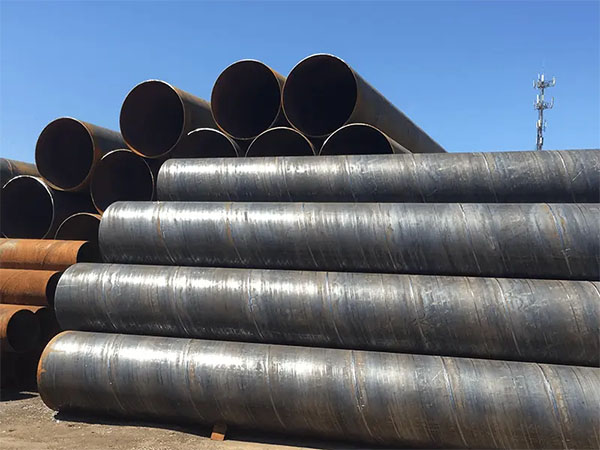The weld seam is the weak link of
welded steel pipes, and its quality directly determines whether the pipeline can operate stably for a long time. If the weld seam has defects such as cracks, pores, slag inclusions or incomplete fusion, it may lead to leakage at the least, and pipe bursts or even engineering accidents at the worst. So what factors can affect the welding quality of welded steel pipes? Then how can control be carried out during the production process? Now I will analyze each point one by one.
1. The quality of raw materials
The quality of the steel itself is the primary factor affecting the performance of the weld seam, which includes
(1) Chemical composition: Excessive carbon content will reduce the weldability of steel and make it prone to cold cracking. When the content of impurities such as sulfur and phosphorus is too high, it will cause the weld metal to become brittle. Uneven distribution of alloying elements may also lead to an increase in the sensitivity of welding cracks.
(2) Surface quality: If the surface of the steel pipe has impurities such as oil stains, rust, and oxide scale, it is very likely to produce pores during welding. If the surface of the steel pipe is uneven or has cracks, the quality of the weld seam will also deteriorate.
(3) Uniformity of materials: If the thickness of the plates or steel strips used for welding is uneven, it will lead to uneven heat distribution during welding, resulting in insufficient penetration. If there are inclusions or pores inside the material, they may extend to the weld zone, reducing the strength of the weld.

2. Welding process methods - Different processes determine different weld seam characteristics
The production processes of welded steel pipes mainly include ERW high-frequency straight seam welded pipes, LSAW submerged arc straight seam welded pipes, and SSAW spiral submerged arc welded pipes. Different methods have different characteristics:
ERW (Electric Resistance Welded) high-frequency straight seam welded pipe: The edge of the steel strip is heated to the molten state through the thermal effect of current, and then pressure is applied to complete the welding.
Advantages: High production efficiency and neat weld seams.
Disadvantages: If the current or pressure is not properly controlled, defects such as incomplete fusion and slag inclusion are likely to occur.
LSAW (Longitudinal Submerged Arc Welded) straight seam Submerged Arc Welded pipe: Utilizing submerged arc welding technology, the weld seam has good deep penetration and is suitable for large-diameter thick-walled steel pipes.
Key control points: Arc stability and flux quality; otherwise, incomplete penetration and slag inclusion may occur.
SSAW (Spiral Submerged Arc Welded) Spiral Submerged Arc Welded pipe: The weld seam is in a spiral shape, has good pressure-bearing capacity, and is often used for long-distance transportation pipelines.
Defect risk: If the lap Angle of the weld seam or the welding parameters are not accurately controlled, it may cause misalignment of the weld seam or stress concentration.
3. Welding process parameters - directly determine the microstructure and properties of the weld seam
The selection of welding parameters is of vital importance. Common parameters include:
Welding current and voltage: Excessive current → The weld penetration is too deep, resulting in burn-through. Too low current → Insufficient fusion of weld metal; Unstable voltage → unstable arc, prone to gas holes.
Welding speed: If the speed is too fast → the weld seam is not fully penetrated and cracks are prone to occur. Too slow speed → excessive heat input, resulting in coarse grains in the weld seam.
Heat input control: Excessive heat input: Excessive grain growth of the metal in the weld zone, reduced toughness; Insufficient heat input: The weld seam lacks fusion and has insufficient strength.
4. Post-weld heat treatment (PWHT) - Stress relief and microstructure improvement
For high-strength steel and thick-walled steel pipes, post-weld heat treatment is an indispensable process.
Eliminating residual stress: During the welding process, due to rapid cooling and heating, a large amount of stress will remain in the weld seam and heat-affected zone. Tempering or annealing treatment can reduce stress and prevent cracking in the later stage.
Improving weld microstructure: Post-weld heat treatment can refine the grain structure and prevent the decline in toughness caused by coarse grains. For alloy steel pipes, it can also reduce hardened structures and enhance plasticity and toughness.
5. Inspection and Quality Control - The final checkpoint to ensure the reliability of weld seams
Weld seams must undergo strict quality inspection. Common methods include:
Non-destructive Testing (NDT
Ultrasonic testing (UT) : Detects internal defects in welds;
Radiographic testing (RT) : Intuitive detection of internal pores and cracks in welds;
Magnetic particle testing (MT) : Suitable for detecting surface cracks;
Penetrant testing (PT) : It is used to detect fine cracks or pores on the surface.
Hydrostatic test
Inject water into the steel pipe and apply pressure to test its sealing performance and pressure resistance.
Visual inspection
Check whether the weld seam has surface defects such as incomplete penetration, undercutting, and weld beads.
Conclusion
The weld quality of welded steel pipes is influenced by multiple factors, including raw materials, welding processes, welding parameters, operational skills, post-weld heat treatment, quality inspection, and production environment. Only by comprehensively controlling these factors can it be ensured that welded steel pipes comply with international standards such as API 5L, ASTM A53, and EN, and play a reliable role in fields such as oil and gas, construction engineering, and water supply pipelines.
